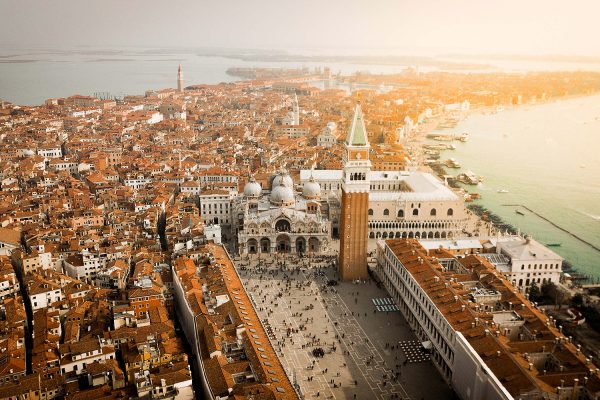
Italians elected new regional councils and governors in the Aosta Valley, Apulia, Campania, Liguria, Marche, Tuscany and Veneto on Sunday and Monday.
They also voted in a referendum to reduce the number of lawmakers in the Chamber of Deputies from 630 to 400 and in the Senate from 315 to 200.
The right has gained control of one more region — Marche — but the center-left Democrats held their own in the regions they governed.
The populist Five Star Movement, which shares power with the Democrats nationally, underperformed everywhere.
Aosta Valley
With half the votes counted, the far-right League is in first place with 24 percent support, but it is unlikely to find coalition partners. Local parties representing the region’s French-speaking minority are projected to win a majority of the 35 seats in the Regional Council between them.
Unlike in other regions, the president of the Aosta Valley is elected by the council rather than voters.
Apulia
President Michele Emiliano’s left-wing coalition has won 27 out of 51 seats in the Regional Council, down three from 2015, with 47 percent support.
His challenger, Raffaele Fitto, who governed the region in the heel of Italy from 2000 to 2005 for Silvio Berlusconi’s Forza Italia, but who ran this year as a candidate for the far-right Brothers of Italy, won seventeen seats for the right, up four, with 39 percent support.
The balance went to the Five Star Movement.
Campania
Incumbent president Vincenzo De Luca, who gained notoriety, and praise, for his no-nonsense approach to keeping Campania — which includes the city of Naples — almost entirely free of coronavirus, won an overwhelming 69 percent support, up from 41 percent. His right-wing challenger, Stefano Caldoro, mustered just 18 percent, down from 38 percent in 2015.
It seems likely the combined left will gain seats in the Regional Council. It currently has a wafer-thin majority of 26 out of 51.
Liguria
Incumbent center-right president Giovanni Toti was reelected with 56 percent support. Ferruccio Sansa, who was supported by both the Democrats and Five Star Movement, got 39 percent.
The combined right gained nine seats in the Regional Council. It now has a comfortable majority of eighteen out of 31.
Marche
The right’s Francesco Acquaroli has won the presidency of Marche with almost 50 percent of the votes. Incumbent president Luca Ceriscioli, a Democratic, did not seek reelection. His successor, Maurizio Mangialardi, won 37 percent support. Five Star candidate Gian Mario Mercorelli placed third with 9 percent.
It seems likely the left will lose seats in the Legislative Assembly. It currently has fifteen out of 31.
Tuscany
Democrats defended their left-wing stronghold in the north of Italy with 48 percent support for Eugenio Giani, a former mayor of Florence — the same share his predecessor got in 2015.
Preelections polls had put Giani’s support in the low 40s.
The League also exceeded expectations with 40 percent support for its candidate, Susanna Ceccardi, up 10 points.
The combined left is projected to maintain 25 out of 41 seats in the Regional Council. The right would gain four seats at the expense of the Five Star Movement.
Veneto
Incumbent president Luca Zaia was reelected with 77 percent support, up from 50 percent in 2015. Like De Luca in Campania, he is credited for controlling the outbreak of coronavirus disease in the region around Venice.
It is likely the combined right will gain seats in the Regional Council. It currently has 28 out of 51.
Takeaways
- Matteo Salvini made a big mistake when he left the government in 2019. His League was polling at ~35 percent support at the time. He clearly hoped to win snap elections. He did not expect his erstwhile coalition partners in the Five Star Movement to team up with the Democrats. The government is now even less likely to collapse. Many right-wing voters, dismayed by Salvini’s opportunism, have switched to the Brothers of Italy.
- Giorgia Meloni is the new star of the Italian right. Support for her Brothers has been steadily rising for a year. She is still some 10 points behind Salvini in the polls, but the momentum is on her side.
- If there is a leadership challenge in the League, it is most likely to come from Zaia. An old-style northern autonomist buoyed by his victory in Veneto, he represents the faction that always doubted Salvini’s attempt to transform the (formerly Northern) League into a national right-wing party.
- The Five Star Movement is a spent force. It can take solace from winning the referendum, which was its idea, but its candidates lost everywhere. The party came to power with grand promises of reform, but slogans and online democracy turned out to be poor substitutes for competence. (Who could have known?) Like all populists, they had to come to terms with reality — and disappoint their supporters.
- Democratic Party leader Nicola Zingaretti, who repudiated the “Third Way” centrism of former prime minister Matteo Renzi and placed the Democrats firmly on the left of the spectrum, can claim vindication, but he should be careful not to overreach. The only left-wing populist who won this weekend was Emiliano in Apulia. De Luca and Giani ran conventional campaigns in Campania and Tuscany, respectively, and won the support of centrist and even some center-right voters in the case of Giani, who wanted to keep the right out of power.
- If there is little appetite for left-wing populism in Italy, there is even less interest in Renzi’s liberal-centrism. His new party, Italia Viva, won barely any seats.

Excellent analysis!
Thanks, Frances!